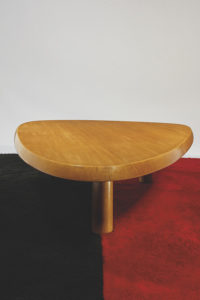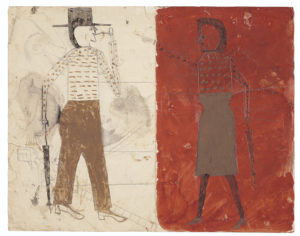Christie’s, Collectors, and COVID-19: An Interview with John Hays
by Taryn Clary
When non-essential businesses around the globe closed in response to the COVID-19 outbreak, Christie’s, like other arts institutions, made the quick shift to remote work. For an auction house with locations in 46 countries and a schedule of around 350 auctions annually, this entailed a nimble dance of sale postponements, greater reliance on private sales, and a major push for online bidding and virtual viewing rooms. Larger institutional restructuring has built on these changes, including the creation of a 20th and 21st Centuries department, which unites the Impressionist and Modern and Post-War and Contemporary departments, and an increase in themed auctions that bridge traditional sales categories.
With almost forty years of experience at the company, John Hays, Deputy Chairman of American Furniture and Decorative Arts, has a uniquely panoramic perspective on how Christie’s has and continues to adapt. Hays shares his thoughts on the ways in which collecting at Christie’s has changed, and what challenges and opportunities lie ahead.
This interview has been edited and condensed for clarity.
How have collectors responded to the shift to online-only sales?
I’m impressed that perhaps because people are sheltering in place and have time on their hands, the pivot to online sales has been stronger than anyone thought it would be. Now I don’t know if this can be sustained at the top of the market. It’s human nature to want to see things physically if it’s possible. Some markets demand that more than others. With American furniture, for example, the process of looking and holding and seeing in person is something that will be harder to give up, albeit pieces are selling. Has it diminished prices? You never know the answer to that. But the experiential part of art is much better in person. When this situation that we find ourselves in passes, when people are confident to go out again, I think people will rush back. The pivot to the computer is an indicator of how much people love looking at art, but it hasn’t come near to the in-person experience.
Have you found differences between how new and experienced collectors are using this time at home to engage with online resources and become more knowledgeable about the art market?
What’s been surprising to me is that an older generation is wrestling to take on this technology. They didn’t give up, they have adapted. The ardent collector has been figuring out how to use their laptop to stay in touch, and that’s true for any age. There may be some exceptions, but by and large at least in American Furniture, I’m surprised in conversations with collectors how they have inculcated themselves to technology. I’ll put myself in this group. I didn’t even have a laptop in March. I’ve gotten myself much more familiar with technology because we’ve had to. Collectors will call me when they look up results of smaller auction sales online and ask if I’ve seen them. It has sped up the dance that we have with technology.
Did it help that Christie’s had already begun developing the infrastructure for online auctions?
I’ve been watching as an observer as catalogues are moved online, and I can see that the art field is embracing new collectors who were not previously part of our community because online means the world. Even in areas where it takes a long time to become an expert, the ability to zoom in, to take courses online, and to view virtual seminars and symposiums, that’s much more attainable than traveling to New York to see what’s going on [in the galleries]. I think it’s expanded the base and deepened interest. We’re enjoying the benefits, but other fields are too. In a strange way we’re competing for airtime with the bigger departments.
Following the pandemic, do you see a future in which all sales are moved online, or will the live auction remain a key part of the Christie’s business model?
It will be interesting when this time period ends to see what permanent effects technology has had in our field, or if we go back exactly to the way it was. American Furniture and Decorative Arts is a very social field. People really enjoy each other’s company, the camaraderie, and the exchange of information in person. I think there will still be a strong desire to return to that way of life, but technology will definitely have changed the paradigm as a useful tool. How could it not? This is just speeding up what we’re all looking at and how we communicate with each other.
I remember I was at a symposium at Christie’s and a PowerPoint presentation was given, and everybody was in awe thinking, “This is just amazing,” having what was formally a slide up on the screen, and “boy we all have to really get familiar with this technology.” Today it’s not even a PowerPoint presentation. It’s actually the person on screen giving a live lecture. So I’m completely in awe of technology, but I still, and maybe this is a romantic idea, but I still value being in person, and I think everybody else does too. I would prefer if we were sitting together at Christie’s having this interview.
Is that especially true as an experienced auctioneer leading a dynamic saleroom?
We have for about a decade now had internet bidding. There is this funny feeling you have when you’re speaking to the internet bids because it’s almost a one way conversation. With this Friday’s sale [ONE: A Global Sale of the 20th Century, which streamed live worldwide on July 10, 2020]… it is a work in progress. There will be four auctioneers in four continents and it will be a hybrid: It will be a live auction at Christie’s, but one that you can bid on online. I think ultimately having that combination is the way to go. It’s a very useful tool to have the internet bidding and it isn’t that we’re unwilling to just go all the way online; it’s that the watching of an auctioneer, even if you’re only doing it on your computer, still seems to us to have an advantage. (The global, relay-style sale went on to fetch $420.9 million for 79 lots.)
Are there any specific works you are looking forward to in the ONE sale?

Charlotte Perriand, (1903-1999), ‘En forme’ low table, designed c. 1953 for the house of Jacques Martin and Charlotte Perriand in Tokyo and executed in 1954 by the Miyoshi Mokko workshop. Hinoki cypress and Manchurian walnut, 14 5/8 x 78 1/2 x 45 5/8 in. (38 x 199.5 x 116 cm.). Sold for €550,000 on July 10, 2020 at Christie’s Paris.
That’s an interesting sale by itself because it’s really a hybrid of Post-War, Contemporary, and Impressionist. It’s sort of like asking somebody what their favorite song is, it depends a little bit on what your mood is. Speaking for myself, even though I’m in the American Furniture and Decorative Arts field, I love art so there are a lot of intriguing pieces that the ONE sale has incorporated. There are works that I don’t know anything about, and it shows you from a generational point of view that there’s a whole new group of people creating art. There’s a great [Joan] Mitchell, there’s a great [Alexander] Calder. Even some works that we would have called cutting-edge contemporary in the nineties, that’s twenty years ago so by many standards it’s kind of a classic sale.
With this sale and the creation of the 20th and 21st Centuries department, might we expect a similar union of decorative arts and design or a greater integration of fine and decorative art within the same sales?
It’s an interesting question because when I started at Christie’s in 1983, fields like American Furniture and Decorative Arts were in one catalogue with American paintings. We had come out of a terrible recession in 1981-1982, so there was a consolidation going on then, and Impressionist Paintings was just leaping forward. With the rise of art prices, everything began compartmentalizing into smaller departments. I think what happened since then was the supply of great works, Impressionist works specifically, began to dwindle. They were in museums and institutions, locked up in collections that were static. So where did the collectors move to? They moved to Modern and Contemporary. This idea of being in one catalogue and one department is recognition that there are fewer and fewer masterworks in Impressionism, and more and more works in Contemporary. It’s also a pretty good indicator of where the liquidity in the market place is, which continues to move toward Contemporary.
What about American furniture? It too has a very small number of masterworks that come on the market every year. So could we see a consolidation of American decorative arts and American paintings? It’s uncertain, but seems like a possibility, doesn’t it? It depends on a lot of factors. The supply of top works is one driver of that decision, but it’s also driven by the collectors. It makes sense from the auction house’s point of view because of the reality of supply in the market place. But I’ll view it as an opportunity to expand the market in these areas.
Have you seen a change in what objects people have gravitated toward over the last several months?

Bill Traylor (c. 1853-1949), Man on White, Woman on Red / Man with Black Dog, double sided, 1939-1942. Tempera and graphite on paper, 18 7/8 x 24 in. Sold for $507,000 on January 17, 2020 at Christie’s New York.
I’m incredibly proud of Cara Zimmerman’s knowledge and expertise that she’s brought to Christie’s in the field of Outsider and Folk Art. We’ve sold in this category for thirty years, but the increase in sales and interest over the last five years demonstrates how important it is to have somebody who is as knowledgeable as Cara communicating internally and externally to our clients, because the conversation she has about individual works of art, how they fall within an artist’s oeuvre, has brought us to a level that we had not attained. Now I look at Bill Traylor and William Edmundson as some of the big names. Even more artists who we might not necessarily have known, disenfranchised people who had received less focus. We’ve seen collectors of American furniture and decorative arts, as well as collectors of contemporary art, move to this space, so it’s been quite a journey. Expansion has certainly occurred in Outsider art.
What advice would you give to people interested in buying and selling American decorative arts at this time?
It’s a buyer’s market. It’s a field in which one of the roadblocks over the past thirty years has often been the price, where you’re competing with people with great resources to pursue the very top pieces. In a strange way, the market we’re in now, though extremely selective because of a lack of supply, is also an opportunity to acquire really good, exciting pieces at a lower price point. People may look at material that comes up in our field as, well, I hate to use the word old-fashioned but old-fashioned. Now is the time to look at art in any field where prices are more attainable. I’m still as excited today as I was thirty years ago about the field, but I think the objects themselves will be looked at perhaps more for their intrinsic beauty and if they meet certain timeless criteria of form. Usually the history of a piece in our field could make up half the value or even more, so I hope people will still be excited about the history as well.
What comes next?
Right now we’re in a period of hoping more great pieces will come on to the market, and I think they will in time. It’s definitely a seller-driven market, not a buyer-driven market, which is often misunderstood. If you have a [Mrs. J. Insley] Blair sale or a [Mr. and Mrs. Eddy] Nicholson sale or these great collections we’ve had the opportunity to sell, new buyers come out because of the enthusiasm for American pieces. We hope great collections will continue to come and then the buyers will be there.
About The Decorative Arts Trust Bulletin
Formerly known as the "blog,” the Bulletin features new research and scholarship, travelogues, book reviews, and museum and gallery exhibitions. The Bulletin complements The Magazine of the Decorative Arts Trust, our biannual members publication.









